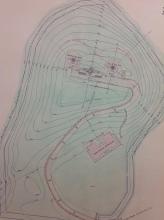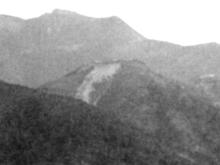Current condition
Ruin
Date completed
(Day is approximate.)
Year Completed is: Accurate
Condition at last visit: Ruin
Date of last visit: Nov-2014
Ref: ROB - 00144
Other: See comments at end of Timeline.
Timeline:
- 1901: Construction commenced in June, estimated cost £7,700. (WO 78/5362).
- 1905: Construction completed in November, actual cost £9,579. (WO 78/5362).
- 1905: Initial Armament: 2 x 6" BL Mk VII guns. (WO 78/5362).
- 1906: 2 x 6" BL guns. (CAB 11/57).
- 1907: 2 x 6" BL guns mounted, to be reduced. (CAB 11/57).
- 1909: 2 x 6" BL guns mounted, to be reduced. (CAB 11/57).
- 1910: 2 x 6" BL guns mounted, no longer approved. (CAB 11/57).
- 1911: 2 x 6" BL guns mounted, to be reduced. (CAB 11/58).
- 1912: Pinewood Bty of 2 x 6" guns "captured" during an exercise in March. (WO 32/5316).
- 1913: July: Reference to "on the ridge on which the old Pinewood Bty is situated". (WO 32/5316).
- 1915: Not listed. (WO 32/5316).
- 1940: Rebuilt for 2 x 4.5" HAA guns, which were never installed. (WO 106/2379).
- 1941: 2 x 3" AA guns at time of war in December. Heavily bombed and shelled, one gun destroyed, the other damaged. Site abandoned 15th December. (WO 172/1687).
- 2014: The ruins are now part of the Pinewood Bty Heritage Trail.
For a background to these notes, and a glossary of terms used, please see: http://gwulo.com/node/24630
Previous comments from philk:
This is where Booth found the skeleton of the Japanese soldier. Some photos of the remaining structures below:



Comments
Pinewood Battery in the press
There was an article about it in The Standard this week.
The article also mentions that the area "is also home to the spectacular Lugard Waterfall". At first I thought I hadn't seen it, but a quick google search shows it's the name of the waterfall along Harlech Road, also mentioned by Booth.
Pinewood Battery in the press, again (6th Feb 2009)
Hi there,
Ming Pao featured the Pinewood Battery today, with some photos, and a interview video clip on site with Tim Ko.
Best Regards,
T
Pinewood Battery As Seen by Experts
Here's the appraisal for a grade II listing for pinewood battery. It's quite detailed though clearly a lot is still unknown by the experts
Historic Building Appraisal Pinewood Battery, Lung Fu Shan, H.K.
Unusually located 307 metres above the sea level, Pinewood Battery now deserted (松林廢堡) is the highest of all the coastal defence batteries in Hong Kong and is very high by comparison with coastal defence batteries located in other parts of the world. While Pinewood Battery was associated with World War II, it was originally built in 1901-1905, apparently to ward off a perceived threat from Russia and France. Costing a total of GBP 9,579 at the time, it was meant to defend against western entry to Hong Kong harbour. Two six-inch Mark 7 guns were installed, each able to fire a 100-pound shell over a seven-mile range.
However, shortly after its completion, Pinewood Battery was designated as “surplus to requirement” in 1906. The government was worried about the high cost of maintaining Hong Kong’s coastal defenses. And, the two guns at the battery were removed in 1913. With the development of air power during World War I, it was decided that Hong Kong needed an anti-aircraft defense, and Pinewood Battery was drafted back into use in the mid 1920s with the installation of two three-inch Mark 1 anti-aircraft guns. Several buildings and shelters were added to the complex at the same time.
A week after their attack on Hong Kong, the Japanese directed extensive airborne operations towards the Island. On 15 December 1941, positions and military installations on the western side of Hong Kong Island were raided by the 23rd Army Air Group. The Pinewood Battery, manned by soldiers from the 17th Anti-Aircraft Battery of the 5th Regiment of the Royal Artillery, was air-raided several times by the Japanese bombers. It was abandoned on the 15th after an anti-aircraft gun was destroyed and other equipment damaged during one of these air raids. On Christmas Day, 1941, Governor Mark Young surrendered to the invading Japanese. Pinewood Battery later fell into disuse.
The pinewood Battery consists of a group of now ruinous buildings and structures largely of concrete construction situated on two flat platform or terraces at the top end of Hatton Road just below the junction with Harlech Road. The two gun emplacements are sited on the upper terrace in tandem facing in a north-west direction, with the battery command post situated in a central position behind them on a tangential axis. The fire control tower (battery observation post) is sited at the rear behind these structures on a central axis with the No. 2 gun emplacement. The battery magazines are built in stone revetted recesses or revetments in the hillside or slope around the lower terrace and are served by a semi-circular battery path which encompasses the site.
Flights of steps connect the two terrace levels and Hatton Road. There are several other smaller ruins of battery buildings (purpose unknown) scattered about approached by footpaths or steps. Each gun emplacement consists of an octagonal concrete platform with a protective concrete parapet wall all round. There is a circular concrete base for mounting the gun in the center of each emplacement. Cropped ends of holding down bolts can be seen. Remains of concrete boxes, probably expense stores or emergency shelters, are situated around the inside of the walls. These were presumably fitted with steel doors originally. A small brick built structure flanked by concrete retaining walls on either side is situated in a central position at the rear of the gun emplacements. The purpose of the structure is not known but it could be a blocked up entrance or portal may have been blocked up for safety reasons. There is another small two storey structure at the rear and to the side of the No. 2 gun emplacement but again its purpose is not known. It may have been a searchlight emplacement. All structures are in a very ruinous condition and the ground around them well worn by erosion.
The battery command post is a rectangular single storey structure with access to the flat roof by means of a ramp. The roof slab projects on three sides to form a continuous cantilevered canopy giving protection to the doors and windows underneath. The roof has a high parapet wall on three sides. Slots in the top of the wall indicate that the roof may have had some sort of cover over it such as a camouflage net or tarpaulin supported on posts. A triangular indentation in the center of the roof slab indicates where a piece of equipment was once installed. The structure is badly war damage. The battery observation post, or fire control tower, is a simple square concrete block with a single room with door and window openings on the ground floor, and a flight of steps up to the open flat roof which has a parapet wall all around it. The structure appears to be in sound condition. A flight of steps in front of the tower leads down the slope on the left to a ruinous structure built into the side of the hillside. The purpose of this second structure is not known.
A few of the old magazine building still remain. They are simple concrete rectangular structures built on platforms cut into the hillside. Cross walls at intervals form individual compartments for the storage of shells and explosive. All steelwork has long since been removed for scrap. A crude attempt at breaking up the outline of the structures has been made by forming a wavy roof line however aerial photographs of the battery clearly indicate its purpose.
There are several rectangular concrete bases at various locations scattered over the site which were probably where administrative and other battery buildings such as accommodation blocks, ablutions, cookhouse, generator house, oil stores, etc., once stood. If the original CRE drawings can be found it should be possible to identify these various locations.
Electricity supply for operating the guns and the searchlights was probably provided by diesel fueled generators. A water supply would have been necessary for fire fighting purposes, cooking, drinking, ablutions, etc., but how it was supplied to the battery is not known at this time. A small square concrete structure which appears to be a water storage tank stands in front of the battery command post. Drainage arrangements from the site also are not known. The present septic tank and filtration tank for the public toilet are modern installations constructions in 1982.
Although the site is interesting and well visited by the public, it is less historic and architectural value than say Lyemun, and generally conforms to the typical design of coastal batteries in Hong Kong. However, it would seem well worthy of at least a Grade 3 rating and possibly more after further research is completed.
All the old battery buildings are in ruinous condition showing signs of serious structural damage sustained in the Japanese air raids on the battery in 1941. Two of the old magazines were demolished in fairly recent times. Further demolitions should be discouraged as well as any attempts by LCSD to alter any of the structures drastically or to brighten them up. (A request was made some years ago to “whitewash” the old gun emplacements – fortunately this was not done).
The site and the buildings are managed by the LCSD but maintenance is the responsibility of the Architectural Services Department. The site is now known as Pinewood Picnic Area under the administration of the Leisure & Cultural Services Department. Picnic tables, benches and BBQ pits have been constructed also a public toilet in 1982 and a pavilion in 1984. The area is highly patronized by local people (morning walkers and picnicers) also tourists especially on Sundays and public holidays. Unfortunately there have been some serious cases of vandalism on several occasions. Perhaps because of its military history, Pinewood Battery has become a favorite location for war gamers. Although the Hong Kong government has made war gaming illegal in the area, one can occasionally find plastic pellets – evidence of a recent military exercise by make-believe soldiers. Pinewood Battery has distant group value with the historic buildings found on the Peak District.
Primarily a picnic site and resting point for curious hikers, today the remnants of Pinewood Battery provide a reminder of the effects of World War II on Hong Kong.
http://www.lcsd.gov.hk/CE/Museum/Monument/form/Brief_Information_on_proposed_Grade_II_Items.pdf
re: Appraisal info
80skid, thanks for adding this. There's a lot of good information in the appraisal docs, and their current mapping system is tortuous to use. Converting the appraisal document to a set of Places so they can be mapped here can be a good project if anyone is interested.
Scout camp
Stephen Davies adds a new entry for the timeline: Scout camp. For several years between the initial battery falling out of use, and its later re-development as an AA battery, the site was used by the Scouts.
On the page for Ching Yuen Garden, he writes:
[1924] was shortly after, interestingly, Pinewood Battery ceased being a military location, was resumed by the government and handed over to the pretty new Hong Kong Scouts as a sort of Gilwell Camp location. Not sure how long that lasted, but not beyond c.1930 (have yet to find the smoking gun for military resumption).
And adds further information at: https://gwulo.com/comment/55231#comment-55231